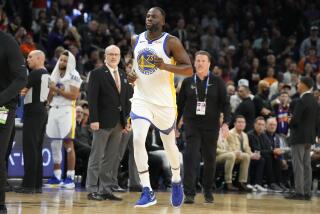Green Knows His Feet Can’t Carry Him Forever
- Share via
CARLISLE, Pa. — Darrell Green’s swift feet have taken him many places during his four years with the Washington Redskins: to two Pro Bowls, to within diving distance for touchdown-saving tackles of breakaway runners Tony Dorsett and Eric Dickerson, to 14 interceptions, to admiration and respect around the National Football League.
Yet Green realizes he’s gone about as far as he can go relying on those feet of his. Speed has made him a success. That’s obvious. But it’s technique, a relatively new word in Green’s vocabulary, that will keep him on top of his game.
“He has gotten himself in trouble a lot of times and has known he could get out of it by getting to the receiver in time to make the play,” said assistant coach Emmitt Thomas. “Right now, he’s just playing on sheer, raw ability. So he is trying to become more conscious of other things.”
Most days after practice at the Redskins’ training camp at Dickinson College, Green sidles up to Art Monk, Gary Clark or another receiver and takes a personal survey. Did they like his new technique? He gets the “pros and cons,” he says, and talks to Thomas, his new adviser, about whether to keep the particular move or not.
“I’m working on my technique, to slow the receiver down as he comes off the line,” Green, the Redskins’ starting left cornerback, said this week. “This is as opposed to the way I played (in the past), giving the receiver the opportunity to do what he wanted to do and being in a position to use my ability to be where I needed to be when the ball comes.
“I’ve had a lot of success in four years covering the way I cover. But I think with the game going the way it’s going, the larger your repertoire of change-ups in coverage, the better your ability to cover. I’ve got to be open to change.”
Green’s new emphasis on jamming receivers at the line, squaring his shoulders as he backpedals and working on watching for the ball comes in stark contrast to the days when he “did a lot of on-the-job training,” he said.
He was so good so fast as a rookie that he began to think he could rely solely on his speed. Nothing in particular happened to change his thinking. Nothing, save a little maturity.
“It was not my intention to come into the NFL and say, ‘Let me show you I’m the fastest guy,’ ” Green said, referring to the time he ran down Dorsett on a Monday night in 1983. “I now want to show I am the best cover guy, I can cover the great receivers.
“I think people recognize me because I’m a Pro Bowler. You don’t go to Pro Bowls on track, you go on football. But, realistically, I am recognized more for speed. I’d like to see that change over, not my speed, but the fact that I can change over to be the guy that you can’t complete a pass on. . . . If I want to be anything in the world of sports, I want to be the best cornerback in the league.”
So Green experiments in training camp, sticking closer to his man, trying to be more patient as a play develops. He has been slowed, ironically enough, by a sprained left ankle, suffered during a pickup basketball game a few months ago. He says he is not in top shape and is not running at full speed yet, which gives him a new appreciation of what being fast means.
“Speed has become such a great part of the passing game,” he said. “You take a guy who has all the technique in the world, and you put him out there against Jerry Rice and Art Monk. Technique is within the first eight yards. After that, there’s no technique. After that, it’s find the ball, because these receivers are faster and faster and faster. Teams are drafting guys that can run fast. They’re concerned about speed. They’re not drafting guys that have technique.”
Green’s dash through the past four NFL seasons also has been a time of personal growth. He’s still 5 feet 8 and 170 pounds; that hasn’t changed. Inside, Green said, is where he is different.
He won the NFL’s Fastest Man competition in 1986 (he didn’t compete this year because of his ankle) and then spoke of trying out for the U.S. Olympic team in 1988. He talked a good game. He seemed a bit unfulfilled, playing football. Track still lingered in his mind from his college days at Texas A&I.;
“At the time, the fastest man (title) meant a lot to me,” Green said. “Ego-wise, it meant a lot, but when I won it, maybe it settled my mind. . . . Now, I don’t worry about who says who’s the fastest because there were a lot of situations (in the last few seasons) where I was able to display my speed against some of the fastest guys in this league. I couldn’t be the fastest man forever. Bob Hayes is just a name now. His name is gone in terms of his football days. You get your time and you keep everything in perspective and you keep on going.”
Green is 27. He never has missed a game as a professional. On the field, he appears as sprightly and happy as he did the first day he put on a Redskins uniform.
“I’m excited,” Green said. “This is my fifth year. I’m batting .500, two Pro Bowls out of four years. . . . I’ve got a lot of high hopes. You get into your fifth year, you feel like you should know what you’re doing, you should be a lot more comfortable, you should be a lot more relaxed. Coaches shouldn’t be on your back as much due to a respect . . . for the fact that you know what you’re doing.”
But Green, a deeply religious man, has a keen sense of his football mortality.
“If I take care of myself and don’t get injured, I could be 32 years old and still running with this speed,” he said. “I’m not afraid of relying on my speed. God gave it to me.”
More to Read
Go beyond the scoreboard
Get the latest on L.A.'s teams in the daily Sports Report newsletter.
You may occasionally receive promotional content from the Los Angeles Times.










